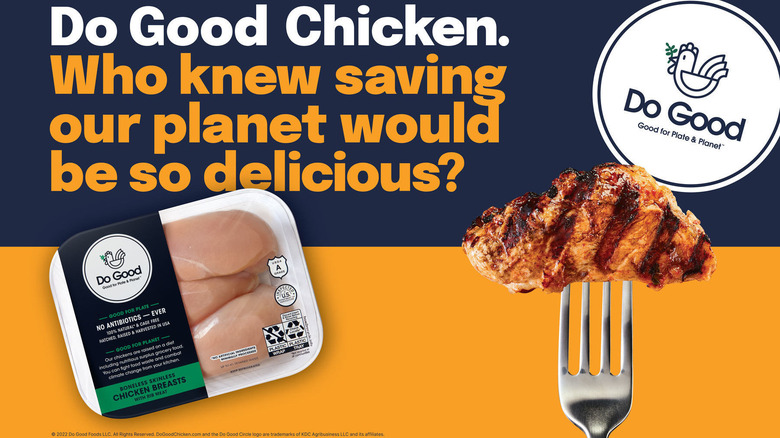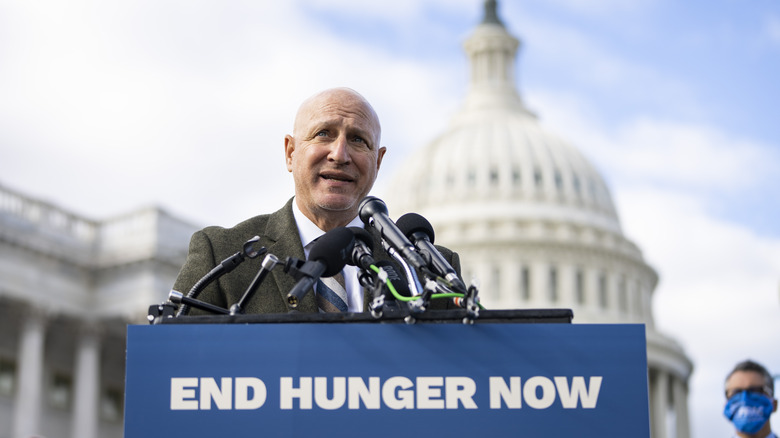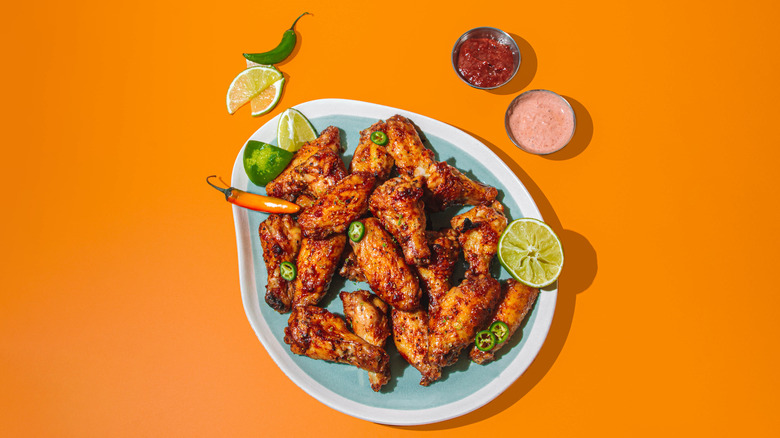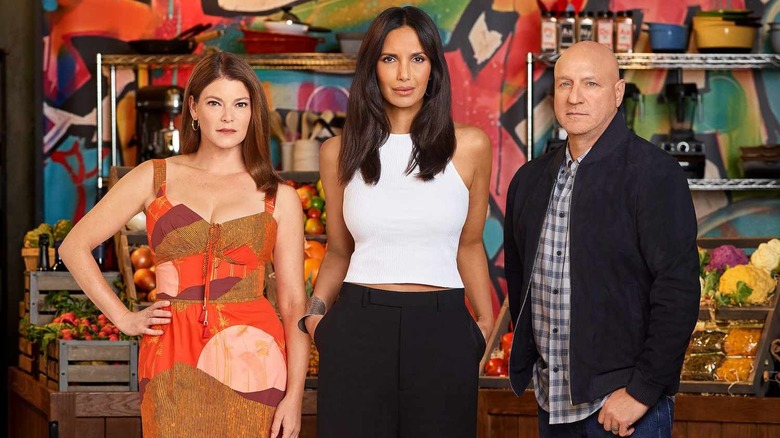Tom Colicchio Talks Super Bowl Parties And Combating Hunger In America - Exclusive Interview
This Sunday, as Americans gather around their flatscreens for our annual celebration of all things gridiron, we will consume vast quantities of that most traditional of Super Bowl party cuisines: the hallowed chicken wing. Chef Tom Colicchio, famed restaurateur and head judge on Bravo's "Top Chef," hopes you'll choose to make your wings from his new brand of climate change-fighting birds, Do Good Chicken.
"Wings are the number one favorite thing during the big game," said Colicchio in an exclusive interview with Tasting Table. "I believe Americans consume about 1.5 billion chicken wings during the Super Bowl, which is crazy when you think about it."
To entice gameday eaters to his new brand, Colicchio has offered a spicy-sweet take on the sticky barbecue classic with a recipe for Sour Cherry BBQ Wings.
When he partnered with the founders of Do Good Chicken six years ago, their mission was twofold: produce humanely-raised, antibiotic- and hormone-free chickens, and feed them on the enormous amount of waste produced by supermarkets every day. By keeping that nutritious food from rotting in the landfills, Do Good's chickens receive a healthy, natural diet while also keeping greenhouse gasses out of our environment.
This project is definitely not Colicchio's first foray into food activism. Since gaining national prominence almost 20 years ago as a television personality, he has been a vocal advocate for issues around food waste, childhood nutrition, and food insecurity. "We can end hunger in this country if we really wanted to," Colicchio said. "We have the resources. It's not an issue of famine. It's not an issue of war. It's not an issue of not having enough. We have plenty in this country. We have to have a commitment to doing this."
During our conversation, Colicchio offered some tips to make your Super Bowl party easy and fun, some pointers to combat food waste at home, and more.
Tackling food waste with Do Good Chicken
Can you talk about how you got started with Do Good Chicken?
Starting about six years ago, I met Justin Kamine. He is one of the family members that is a founder of Do Good Chicken. We met at an event. He's telling me about this idea that he had, and I said, "This is fantastic." We stayed in touch. About six years ago, I came on board as an advisor and have been working with the company ever since.
According to your website, upwards of 40% of fresh, edible grocery products get thrown out each year. How does Do Good Chicken tackle the issue of large-scale food waste?
Food waste happens throughout the entire system. It happens on farms when food is left behind. It happens in processing plants when food isn't the right size. It happens now in the supermarket when things aren't perfect, or they get down to a few little things left and it all gets trashed.
The great thing that Do Good Chicken is doing is they're taking all that surplus food that would get thrown out, that would end up in a landfill and create methane and contribute to greenhouse gasses, and they're turning it into feed for chickens.
Do Good will say, first off, that any surplus food should be donated. But there is no way food banks can actually deal with the amount of surplus food that is being thrown out from supermarkets. We take that [leftover surplus] food and it's pelletized, and then we feed it to our chickens. We give it to our growers. All of our chickens are raised with access to the outdoors, no antibiotics ever, no growth hormone. It's great chicken.
Each Do Good chicken actually represents roughly four pounds of food that would've been thrown out. If you're looking to figure out ways to actually help with the environmental impact that you're making, one simple thing to do is purchase a different chicken. You don't have to do much. You just have to go and buy a different chicken, and you can actually combat climate change.
Can you give our readers some tips about what they can do to reduce food waste at home?
At home, [food waste] happens from people over-purchasing and leaving food behind in the refrigerator. I suggest once a week ... Pick a date. I do it on Fridays. I go through my refrigerator and start pulling out things that I know in a day or two I'm going to throw out. It's usually vegetables — a carrot over here, a piece of cauliflower, some broccoli. I try to make sure that I'm intentional with the way I cook to make sure I incorporate all of that before it gets thrown out.
Then, there's a lot of waste with leftovers. Quite frankly, most people put leftovers in a tray in the refrigerator, and it gets left until it gets thrown out. They don't incorporate that into the next day's meal or the next day's lunch. It's hard to do, especially if you're a busy family. Two parents are working. It's hard to figure all that out. Again, it's a problem of food waste that we have throughout the entire system.
Fighting hunger in American kids
As of summer 2022, nearly 1 in 4 American households reported experiencing food insecurity, an increase of 5% since 2020 at the height of the pandemic. Can you talk about your work around issues of food insecurity?
I've been an anti-hunger advocate for years. My wife, [Lori Silverbush], did a documentary about hunger in America called "A Place at the Table" [in 2012]. It's an issue that I've spent a lot of time with. When we talk about hunger in the United States, it's not like hunger that we see in the third world. It's a little different — it's more of a deficit of nutrition. There's a host of reasons why there's a problem there.
I remember seeing you testify in front of Congress [in 2010] about childhood nutrition. Can you tell us a little more about your work advocating for children and family nutrition?
The three things that make a huge impact on childhood nutrition — especially [for] people that are struggling to put food on the table — are SNAP, school lunch, and WIC — the Women, Infants, and Children [nutrition] program.
I'm a big advocate for lunch that is universally given to every student. My mother ran a school cafeteria. She would spend the majority of her time not on feeding children, but actually trying to figure out who gets it free, who gets reduced, who pays full. They had to spend all their time doing administrative work instead of taking those resources and putting them into actually [providing] healthier, nutritious foods.
If we're giving our kids books and desks to learn, a big component in learning is making sure that you're not hungry. It's impossible to sit through a day and learn if you're hungry. Kids are showing up hungry.
School breakfast in first period is also a part of this — not when they come in early. A lot of times, if they come in early, sometimes transportation's not set up yet. There's also a stigma about coming to school early and getting that breakfast. Studies have found that when kids get breakfast in first period, math scores go up by 13%. The incidence of kids going to the principal's office and getting in trouble goes way down. That's another way to combat hunger.
But the biggest one is the SNAP program, the Supplemental Nutrition Assistance Program, which was known as food stamps. [SNAP makes a] huge difference to parents being able to put nutritious food on the table. Again, we're talking about nutritious foods. We're talking about food that's actually going to fuel you and not junk. The problem right now is a lot of parents are buying food that's not as nutritious because those are the cheaper foods. If you're trying to stretch a dollar, usually you're stuck buying highly processed foods with a lot of sugar.
Nutrition's really important. I believe that part of the school curriculum should be teaching kids about nutrition. Those kids learn, they go home, then teach their parents.
Tips for making your Super Bowl party easy and delicious
With game day on Sunday, you came up with a wonderful recipe for Sour Cherry BBQ Wings. Any pointers to make these chicken wings great?
One of the most important things is if you're going to cook your wings in an oven to roast them, make sure they're really dry. We recommend that you open up your package of chicken wings and expose them to the air in the refrigerator for a couple of days uncovered so they dry out. If you don't want to do that, you can pat them really, really well with a paper towel so they're dry. You can [dust them with] a little baking soda as well to help dry out your chicken.
Season them last second, salt last second, right before they go in the oven — nice high heat. Then the sauce here — it's sour cherries and a little bit of vinegar. There's some serrano chilies, garlic, and onion, and it's all cooked together. Use it as a glaze over the wings.
Any tips for our readers to make their Super Bowl party a little more fun and easier on them?
My recommendation for anybody doing it: Focus on some things that are easy that you're not messing around with at the last second. You don't have to spend all day in the kitchen for the game.
Try to time it where everything is ready [at the same time]. You want snacks around, but you want everything going out at halftime. I know Rihanna's performing this year — everybody wants to watch that, but that's a good time to get everything out there.
Do you have any skin in the game? Are you rooting for anybody in particular?
I'm more of an NFC fan, so I'll go with the green team — Philadelphia Eagles. I'm fortunate. Every three years when NBC broadcasts, I get to go. I bring my son, who is a fan. That's fun. It's a big party.
Here's a game day Quickfire Challenge for you, chef. If you could make a party dish for your friends coming over to watch the game using any kind of canned seafood, what would you do?
Tuna, but you get that really good fancy stuff. I had this for dinner last night. I had tuna I canned myself. I fish, so I process tuna every year. It's easy actually — you put it in a jar with some oil and you put it in a pressure cooker, and it's done.
This isn't going to sound very "game day," but I slice fennel on a mandolin. Slice it really thin. [Use] some bitter greens like verdicchio or endive, a little vinaigrette and the canned tuna, toss it all up — done.
Colicchio on The Menu, The Bear, and Top Chef Season 20
I saw on Twitter last month that you said you didn't much care for the film "The Menu."
Oh, I hated it. I watched it, and early on, it was like all of the culinary tropes they pulled out, and it was so over the top. I [also watched] "The Bear." Compare the two. "The Bear" is so much better — much more realistic. This idea that you're a guest in this dining room and you would sit around while somebody puts some marshmallow ring around you, and you're going to get torched, and you're going to sit there and go, "Okay" — it's crazy. This is crazy. I had such a hard time with it.
I've been watching some teasers for Season 20 of "Top Chef," and it looks pretty intense. You took the show over to London. What can we expect?
There's a bunch of different "Top Chef" productions around the world. There's "Top Chef India" [and] "Top Chef France." There's Mexico, Brazil, Poland ... There's Middle East, Germany. We took either finalists or winners from all of those and brought them all together for an international all-star [competition]. These are contestants that have competed. They've either won or are runners-up in their productions, and [the new season brings] them all together.
Shooting in London was great. I got to live in London for seven weeks — it was fantastic. There's so much culinary excellence in the U.K. The products are amazing, especially dairy, but even produce. I was there in the fall, so there's a lot of great game and amazing fish and shellfish. There's a lot of great raw product there. Of course, there's some amazing restaurants. It's an exciting restaurant town, London. It was a lot of fun. I hadn't been there in a while, so it was fun to be there.
Learn more about Do Good Chicken and grab Colicchio's recipe for Sour Cherry BBQ Wings on their website. Follow Tom Colicchio on Instagram for updates on his latest projects.
This interview has been edited for clarity.




